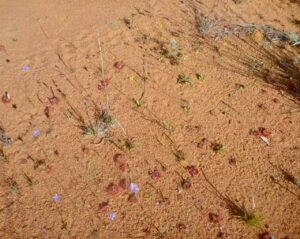Ian Hoch considers how all the aspects of Nature work together at Bimblebox…
This stunning image taken by Greg Harm of the Brown Falcon with its small dragon lizard catch could be the emblem of Bimblebox, as it’s a familiar sight in this land of raptors and reptiles. Both flourish here; one, you might think, at the expense of the other, until you realise… there’s aplenty and a place for all.
That spartan aerial triad of tree, lizard and bird contrasts starkly with the clutter and bustle directly beneath. In wet season these arid woodlands will rival rainforest for terrestrial activity and diversity. While nothing jumps out at you, closer attention divulges a hive of enterprise.
Bugs and grubs and spiders galore, hoppers and butterflies and beetles swarm in a dense variegated carpet of vegetation, and lizards of all sorts harvest the full range of arthropods and also the ubiquitous nevertire termites whose astonishing microbial digestion extracts the last skerricks of energy from long dead grass and bark. With their relentless 24/7 gnawing, they’ve eaten half my life’s share of wood work, and fire the other half; any creature adopting a white ant diet in OZ is on a winner…!
Photo by Greg Harm
In looking down and skyward again some bygone high school biology springs to mind, with vague understated phrases like “food chain” and “web of life” and you begin to get a sense of their true meaning and full function… of how everything in nature fits chaotically together, of how it self-regulates and perpetuates, of how tree, lizard and bird are but three of a conglomeration of organisms and physical forces that create, transport and recycle nutrients otherwise lacking in these timeworn and depleted sandy soils.
Unlike heavy cracking clays of the open “downs” to the east and west, the desert uplands (akin to rainforest) are dependent on organic matter and activity for replenishment. One way to view fertility in the light porous soils of this region is literally – “you’re looking at it” – tied up in the biota. 
Photo by Peter Kuestler
A simple proof is to grab a handful and shake it in a glass of water. Happily on top you’ll find a finger width of debris, then a thin slither of clay particles, and the rest… beach sand. Any gardener worth his broccoli knows you need to feed sandy soil for it to retain water and release minerals. To manage sustainably we’d need to think of this place like a big organic garden, complete with compost regime and crop rotation.
Of course we can slash and burn and concertina eons of growth and decomposition into a couple of human lifespans.
We can go one jump further. Call the living earth overburden, strip it altogether, excavate the black substrate accumulated over millions of years from those same ecological processes.
How extremely convenient for us, in each case, to separate the components of immediate utility and disregard the rest. Both practices are proven to be short-sighted extravagance with disastrous consequences. But still they persist.
On Bimblebox we’re resolved to retain falcon and dragon, as indicative of healthy environment, already hard pressed in cattle country.
You’ll find neither in the bottom of a coal pit.


